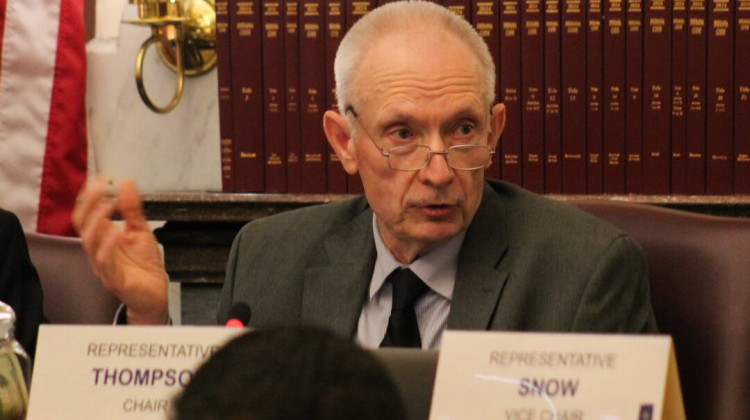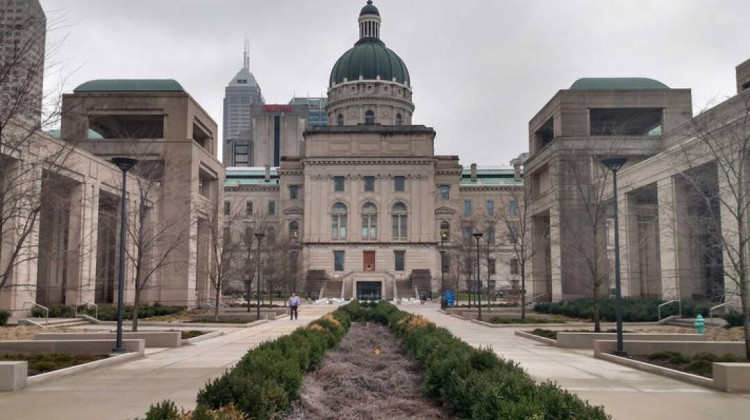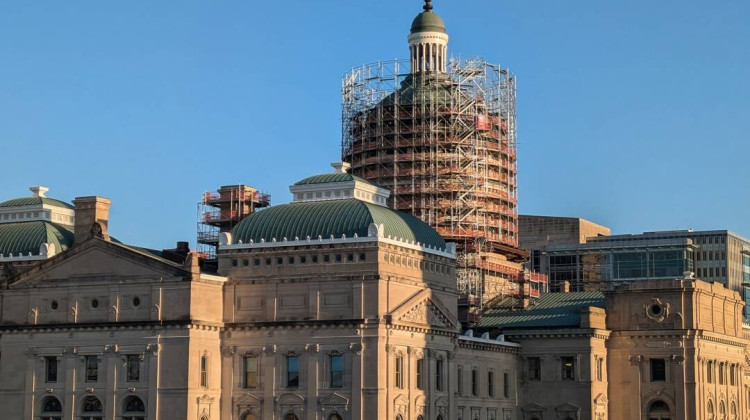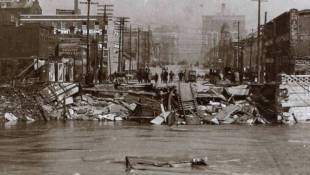DAVID A. LIEB, MICHAEL CASEY and MICHELLE MINKOFF, Associated Press

Water flows over a spill gate on Lake McQueeney, Oct. 2, 2019, Lake McQueeney, Texas. A judge has issued a 12-month temporary injunction preventing the draining of McQueeney and five other lakes along the Guadalupe River after property owners sued. (AP Photo/Eric Gay)
On a cold morning last March, Kenny Angel got a frantic knock on his door. Two workers from a utility company in northern Nebraska had come with a stark warning: Get out of your house.
Just a little over a quarter-mile upstream, the 92-year-old Spencer Dam was straining to contain the swollen, ice-covered Niobrara River after an unusually intense snow and rainstorm. The workers had tried but failed to force open the dam's frozen wooden spillway gates. So, fearing the worst, they fled in their truck, stopping to warn Angel before driving away without him.
Minutes later, the dam came crashing down, unleashing a wave of water carrying ice chunks the size of cars. Angel's home was wiped away; his body was never found.
"He had about a 5-minute notice, with no prior warning the day before," Scott Angel, one of Kenny's brothers, said.
State inspectors had given the dam a "fair" rating less than a year earlier. Until it failed, it looked little different from thousands of others across the U.S. — and that could portend a problem.
A more than two-year investigation by The Associated Press has found scores of dams nationwide in even worse condition, and in equally dangerous locations. They loom over homes, businesses, highways or entire communities that could face life-threatening floods if the dams don't hold.
A review of federal data and reports obtained under state open records laws identified 1,688 high-hazard dams rated in poor or unsatisfactory condition as of last year in 44 states and Puerto Rico. The actual number is almost certainly higher: Some states declined to provide condition ratings for their dams, claiming exemptions to public record requests. Others simply haven't rated all their dams due to lack of funding, staffing or authority to do so.
Deaths from dam failures have declined since a series of catastrophic collapses in the 1970s prompted the federal and state governments to step up their safety efforts. Yet about 1,000 dams have failed over the past four decades, killing 34 people, according to Stanford University's National Performance of Dams Program.
Built for flood control, irrigation, water supply, hydropower, recreation or industrial waste storage, the nation's dams are over a half-century old on average. Some are no longer adequate to handle the intense rainfall and floods of a changing climate. Yet they are being relied upon to protect more and more people as housing developments spring up nearby.
"There are thousands of people in this country that are living downstream from dams that are probably considered deficient given current safety standards," said Mark Ogden, a former Ohio dam safety official who is now a technical specialist with the Association of State Dam Safety Officials.
The association estimates it would take more than $70 billion to repair and modernize the nation's more than 90,000 dams. But unlike much other infrastructure, most U.S. dams are privately owned. That makes it difficult for regulators to require improvements from operators who are unable or unwilling to pay the steep costs.
"Most people have no clue about the vulnerabilities when they live downstream from these private dams," said Craig Fugate, a former administrator at the Federal Emergency Management Agency. "When they fail, they don't fail with warning. They just fail, and suddenly you can find yourself in a situation where you have a wall of water and debris racing toward your house with very little time, if any, to get out."
It's unclear whether Angel, a 71-year-old Vietnam War veteran, declined to flee or simply ran out of time after workers with the Nebraska Public Power District warned him that water was overtopping the dam near Spencer, a town of fewer than 500 residents.
An attorney for Angel's wife, who wasn't home when the dam broke, has filed a $5 million lawsuit alleging negligence. It claims the power utility failed to properly maintain the dam, train its employees or inform the Angels of dangerous conditions.
Even though the Angels' home was squarely in its path, the dam was rated as a "significant" rather than "high" hazard, meaning it wasn't required under Nebraska law to have a formal emergency action plan. About 20% of state-regulated high-hazard dams nationwide still lack emergency plans, according to the U.S. Army Corps of Engineers, which maintains the national dam inventory.
When last inspected in April 2018 , Spencer Dam's "fair" rating was accompanied by an ominous notation: "Deficiencies exist which could lead to dam failure during rare, extreme storm events."
Tim Gokie, chief engineer of Nebraska's dam safety program, said the warning was due to past water seepage the power utility addressed by installing a drain system. Ultimately, Gokie said, the rising Niobrara River simply overwhelmed the concrete and earthen dam, which was built in 1927 to generate hydroelectricity, not for flood control.
"The fact was that it was just an unprecedented situation," Nebraska Public Power District spokesman Mark Becker said. "It was beyond what everybody anticipated."
Nebraska was among the states hardest hit by storms and floods this year that have caused an estimated $1.5 billion in damage to roads, dams, utilities and other infrastructure in 28 states, according to an AP analysis.
A National Climate Assessment released by the White House last year noted growing frequency and intensity of storms as the climate changes. That can push some dams beyond what they were designed to handle.
Even if kept in good condition, thousands of dams could be at risk because of extreme rainstorms, said Fugate, the former FEMA official.
"These are like ticking bombs just sitting there, waiting for the wrong conditions to occur to cause catastrophic failure," he said.
___
The nation's dams are categorized as high, significant or low hazard in the National Inventory of Dams database. High hazard means loss of human life is likely if a dam were to fail. A significant rating means no deaths are likely, although economic and environmental damage are possible.
There is no national standard for inspecting dams, leading to a patchwork of state regulations. Some states inspect high-hazard dams every year while others wait up to five years. Some states never inspect low-hazard dams — though even farm ponds can eventually pose a high hazard as housing developments encroach.
Dam conditions are supposed to be rated as unsatisfactory, poor, fair or satisfactory. But the ratings are subjective — varying by state and the interpretations of individual inspectors — and are not always publicly disclosed.
Since the Sept. 11, 2001, terror attacks, the U.S. government has cited national security grounds in refusing to include dams' conditions in its inventory, which was updated most recently in 2018. But the AP was able to determine both condition and hazard ratings for more than 25,000 dams across the country through public records requests.
The tally includes some of the nation's most well-known dams, such as Hoover Dam along the Colorado River, but mostly involves privately owned dams. Many are used for recreation.
The AP then examined inspection reports for hundreds of high-hazard dams in poor or unsatisfactory condition. Those reports cited a variety of problems: leaks that can indicate a dam is failing internally; unrepaired erosion from past instances of overtopping; holes from burrowing animals; tree growth that can destabilize earthen dams; and spillways too small to handle a large flood. Some dams were so overgrown with vegetation that they couldn't be fully inspected.
Georgia led the nation with nearly 200 high-hazard dams in unsatisfactory or poor condition, according to the AP's analysis.
Among them is Reservoir No. 1 in Atlanta, a 180 million-gallon water supply dating to the late 1800s that has been out of service much of the past few decades. The city made repairs and brought it back online in 2017, only to shut it down again after leaks were noticed.
If the dam were to catastrophically fail, the water could inundate more than 1,000 homes, dozens of businesses, a railroad and a portion of Interstate 75, according to an emergency action plan .
Joel Iverson has previously noticed water trickling out of the dam near the brewery he co-founded, Monday Night Brewing.
"If that one goes, it's going to wash away us and a lot of beer," Iverson said.
The Atlanta Watershed Management Department declined the AP's request for an interview about the reservoir and instead asked for questions in writing. When those were submitted, it declined to answer them.
___
One of the most common problems for aging dams are spillways incapable of handling an extreme rainfall event.
If water can't escape quickly enough through spillways, it could flow over the top of a dam, which increases the probability of rapid erosion that can cause it to collapse.
The spillway at the 107-year-old Willett Pond Dam near the Boston suburb of Norwood is capable of handling just 13% of the water flow from a serious flood before the dam is overtopped, according to a recent state inspection report. If the dam were to give way, it could send hundreds of millions of gallons of water into the heart of the city of nearly 30,000 people.
"We are not talking of just flooding someone's house. We are talking about covering their house," said Murray Beach, who lives on the shore of the 220-acre privately owned lake and belongs to a citizens group that has lobbied for years for the spillway to be repaired.
A 2017 inspection report said improvements to the spillway could cost between $1 million and $5 million. A nonprofit that owns the lake received a $215,000 state grant last year to design spillway improvements. But there is no timeline to fix it.
More than 1,300 properties lie within the dam's inundation zone, including several shopping centers and at least two elementary schools, as well as more than 70 roads and two railroads.
Tamiko Porter, who operates a Montessori school serving some 75 students, said she was surprised to learn there was a dam upstream that could flood her school if it failed.
"Oh God, please let it happen when my kids aren't here," Porter said.
Norwood emergency management director Bernard Cooper said there is no imminent risk of dam failure.
"Yes, it needs work. The spillway should be rebuilt. Absolutely, no question," Cooper acknowledged. But "there is no money in the system for that."
Concerns about inadequate dam spillways date back decades to when the Corps of Engineers undertook its first nationwide assessment of dams posing a high risk to life and property. From 1978 to 1981, the Corps inspected 8,818 dams. About one-third were deemed unsafe due to deficiencies, and about 80% of those cited inadequate spillway capacities.
One of the dams cited for a "seriously inadequate" spillway in 1978 was Lake Sebago, located in a New York state park near the village of Sloatsburg. Forty years later, nothing has changed.
A 2018 state inspection letter warned of "inadequate spillway capacity and dam stability" and asked for an improvement plan within 30 days. None was provided.
The state dam safety office has no authority to force the state parks department to make repairs.
To modify the Lake Sebago spillway, workers would have to rebuild a road and bridge that pass over the dam. The project could cost over $15 million, said Jim Hall, the recently retired executive director of the Palisades Interstate Park Commission, which manages multiple dams.
"That structure has been in place with the same spillway capacity for over probably 60 to 70 years and it hasn't been overtopped," Hall said. "Should it be improved to meet all codes? Yeah, that would be nice. Does it make it the highest priority for us to do in relation to other dam structures we have? Probably not."
___
In a 1982 report summarizing its nationwide dam assessment, the Corps of Engineers said most dam owners were unwilling to modify, repair or maintain the structures, and most states were unwilling to spend enough money for an effective dam safety program.
Since then, every state but Alabama has created a dam safety program.
But the Great Recession a decade ago forced many states to make widespread budget and personnel cuts. Since a low point in 2011, states' total spending on dam safety has grown by about one-third to nearly $59 million in the 2019 fiscal year while staffing levels have risen by about one-fifth, according to data collected by the Corps of Engineers.
California, which runs the nation's largest dam safety program, accounts for much of that gain. It boosted its budget from $13 million to $20 million and the number of full-time staff from 63 to 77 following the failure of the Oroville dam spillway in 2017.
The scare at Oroville, the nation's tallest dam, led to evacuation orders for nearly 200,000 people, although no one was injured and the dam ultimately held. An independent investigation cited "a long-term systemic failure " by regulators and the dam industry to recognize and address warning signs.
California spent $1.1 billion repairing the Lake Oroville spillway, enacted new emergency plan requirements and launched a review of 93 other dams with similar spillways.
In South Carolina, after more than 70 dams failed following heavy rains in 2015 and 2016, the state tripled the personnel in its dam safety program and ratcheted up spending from about $260,000 annually to more than $1 million.
But some states have continued to pare back their dam safety programs. Thirteen states and Puerto Rico were spending less in 2019 than they did in 2011, and 11 states had fewer full-time positions in their programs.
The Association of State Dam Safety Officials says almost every state faces a serious need to pump additional money and manpower into dam safety programs.
"If you don't have the staff to inspect a dam, or don't have the authority to do that, you don't know what the problems are," said the association's Ogden.
"If you are able to do the inspection but you can't follow up, and you have dam owners who don't have the resources to fix their dam, then ultimately you know what the problem is but you can't get it addressed," he added.
Many states face a quandary when it comes to problematic private dams when they can't identify the owners. Rhode Island's two-person dam safety office last year listed 32 high- or significant-hazard dams with safety concerns whose owners were unknown.
"If we don't know the owner, then we can't take any action to order anybody to fix it," said David Chopy, chief of compliance and inspection for the Rhode Island Department of Environmental Management.
In some states, dams go uninspected because of exemptions in state law.
A 2013 Texas law exempts all dams on private property with a capacity of less than 163 million gallons that are rated significant or low hazard and are located outside of city limits in any county with fewer than 350,000 people. As a result, about 45% of its roughly 7,200 dams are exempt from regulation.
Missouri performs safety inspections on only about 650 of its more than 5,000 dams. That's because state law exempts all dams that are under 35 feet, used for agricultural purposes or subject to federal regulation.
Former Missouri Gov. Matt Blunt attempted to significantly expand the number of dams under state supervision after the mountaintop Taum Sauk Reservoir collapsed in December 2005, injuring a state park superintendent's family. But the legislation failed after some rural landowners expressed concerns. Then the proposal quietly faded away as new officials took over.
"Maybe it's time to take a look at that again and make sure that our dams are safe," said Missouri state Rep. Tim Remole, who now leads the House committee overseeing dam safety.
___
Until Angel's death in Nebraska this year, the last fatal dam failure in the U.S. occurred on the Hawaiian island of Kauai in 2006.
An earthen wall of the Kaloko Reservoir collapsed during heavy rains and sent a wave of water rushing down a hillside. Seven people — including a pregnant woman — were killed on Bruce Fehring's property, including his daughter, son-in-law and grandson.
Fehring, who wasn't there at the time, got a phone call from a neighbor saying something terrible had happened. He was shocked by the scene.
"It took a while to register, and I went, 'Oh my God, everything's been washed away,'" Fehring recalled. "I mean, you have no idea the power of water (until) you see what it can do in a very short amount of time."
Dam owner James Pflueger pleaded no contest to felony reckless endangerment and was sentenced to seven months of confinement and five years of probation. His property company pleaded no contest to seven counts of manslaughter. Prosecutors said Pflueger had filled in the dam's spillway while attempting to make space for a waterfront development.
The victims' families and those whose property was damaged, including actress Bette Midler, agreed to a $25 million civil settlement. Though categorized by the state as low hazard at the time it failed, Kaloko Reservoir is now listed as a high-hazard facility in poor condition . It remains largely unrepaired.
That's also the case with Lake Dunlap Dam, northeast of San Antonio. On a sunny morning in May, one of the 91-year-old dam's corroded spillway gates suddenly gave way. No one was hurt in the rush of water, but scores of homeowners' lakeside docks were left high and dry, facing barren swaths of dried lakebed after the river retreated, leaving boats stranded.
The dam was the second hydroelectric facility along the river to fail within the past three years. The Guadalupe-Blanco River Authority responded with plans to drain a chain of four lakes because of concerns their similarly designed spillway gates also could fail.
But after property owners sued, the river authority agreed in September to a temporary injunction delaying the plan for a year. That could allow time to find funding for the estimated $90 million to $210 million to repair the dams.
"This is something that communities and states all across the country are grappling with as we are reckoning with our aging infrastructure," said Tess Coody-Anders, a homeowner near Lake McQueeney, one of the dams slated to be drained.
"I hope that everyone will recognize that, like in our community, entire economies and ways of life have developed around what started out as a civil engineering project," she added. "And you can't take that away."
Lieb reported from Jefferson City, Missouri; Casey from Concord, New Hampshire; and Minkoff from Washington, D.C.
Associated Press writers Eric Gay in San Antonio and Caleb Jones in Honolulu contributed to this report.
 DONATE
DONATE




 View More Articles
View More Articles





 Support WFYI. We can't do it without you.
Support WFYI. We can't do it without you.